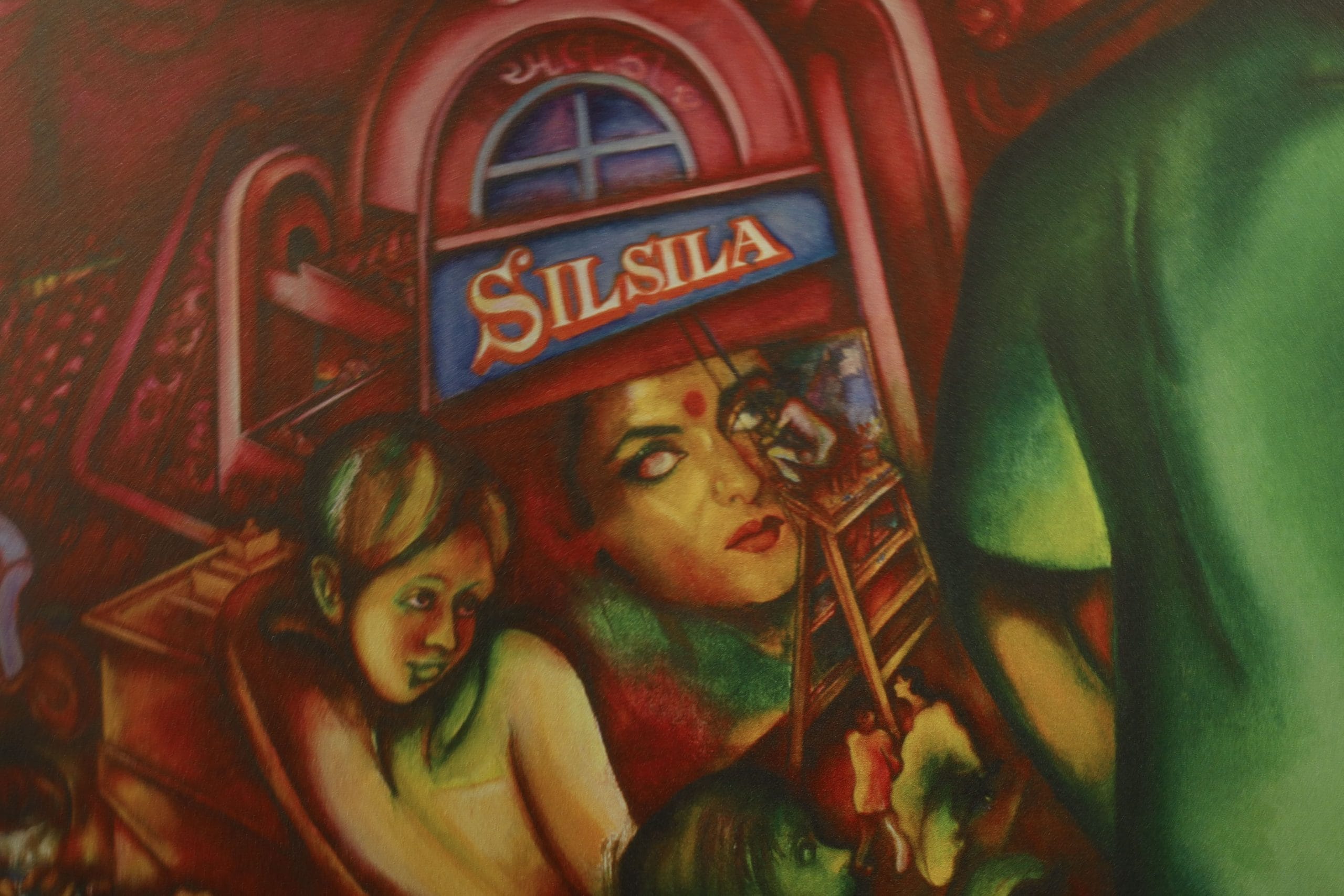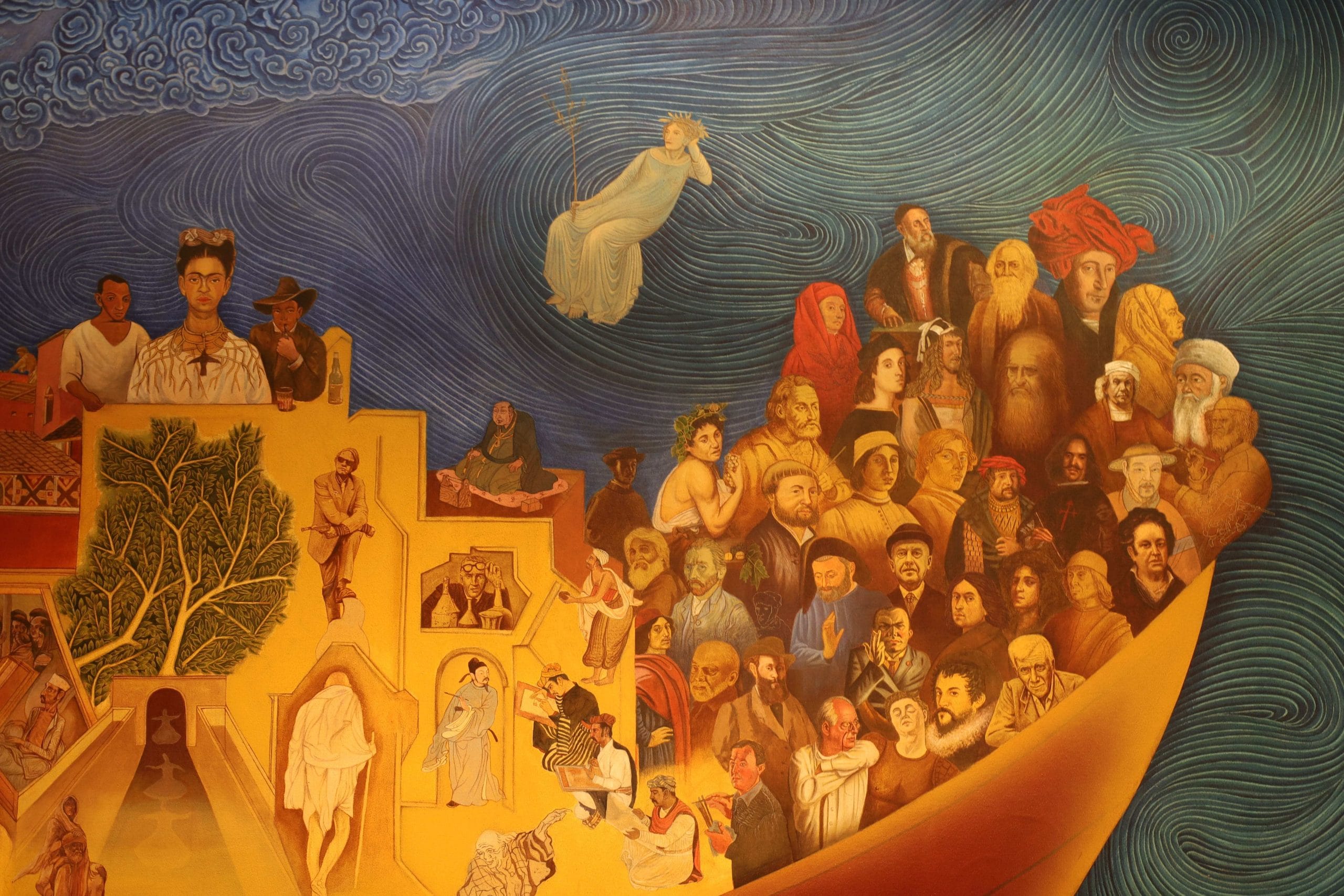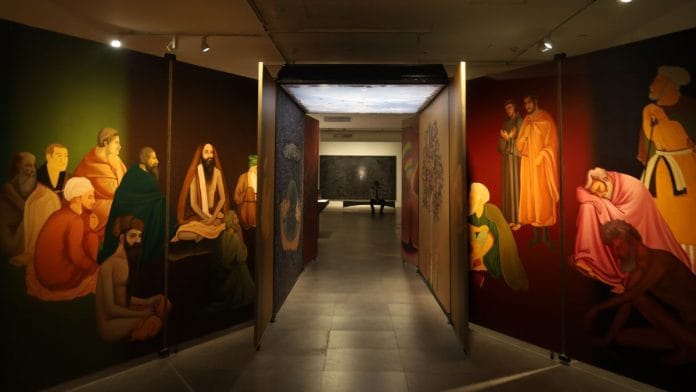New Delhi: Flames rise, monuments fall, and myths collapse into headlines. Gulammohammed Sheikh’s brush holds steady as he traces the haunted contours—the burning embers of the Babri Masjid to the smouldering aftermath of the 2002 Gujarat riots. The retrospective becomes more than a visual archive; it becomes the testimony of a witness who refuses to look away. Its bookending transforms into a hall of mirrors where histories refract and truths multiply. This is where memory settles, leaving behind a residue that won’t wash off the walls of history or the surface of Sheikh’s work.
Sheikh’s Of Worlds Within Worlds exhibition invites viewers into a multiverse of “living simultaneously in several cultures and times”. It is an oscillation where the past is a “living entity alongside the present.”
A fitting tribute to her teacher, curator Roobina Karode describes Sheikh’s work, displayed at Delhi’s Kiran Nadar Museum of Art, as something that “draws us into a definite moment of recognition and then leaves us with a series of questions – about the worlds within us, the worlds we exist in, and the worlds yet to come.”
Mundane and meaningful
In Sheikh’s earlier work, he used a panoramic vision constructed from multiple vantage points in his gouache paintings, somewhat like that of a distant observer or an artistic precursor to Google Maps. After studying in London and traveling extensively across Europe, it’s almost like distance drew his gaze back home: to its details, its people, its textures.

This zoom extends beyond the physical, as metaphysical elements of angels, the Buraq, and Ram hunting the golden deer emerge, creating an eclipse of the physical and metaphysical worlds.
This is particularly evident in the City Structures section of the exhibit, where the curatorial logic mirrors Sheikh’s method: layering, association, and spatial storytelling, inspired by Mughal miniature painting.
Spatial memory gains depth in Returning Home After a Long Absence, a painting created after Sheikh’s return from Europe. It’s not just a homecoming, it’s so much more than that.
When depicting his childhood home, Sheikh chooses to recreate both the mundane and the meaningful. The banyan tree carries an everyday allegorical memory. However, the boundary wall, a constant in his portrayals of home, becomes more than just architecture as it echoes a sense of closure and isolation.
Sheikh’s use of colour also evolves. Initially, the vivid reds serve to capture Gujarat’s searing heat, but slowly begin to shift in meaning, turning into shades of anger, and eventually, blood.
A striking example of this transition is City for Sale, a painting that drew large crowds at the exhibition. Many found themselves trying to “read” it. With its reds and yellows, it resembles a thermal image, highlighting the temperature of communal unrest in Baroda.
Sheikh constructs what he calls a palimpsest-like experience, layers of what is felt but often not recognised or articulated. In one striking detail, a man is painted upside down, his body checked for signs of his religion, while the theatre plays the 1981 film Silsila. The billboard shows one of Rekha’s eyes carefully painted in, and the other left blank. A blind eye, which the society turns toward violence.

Across the room hangs Ahmedabad: The City Gandhi Left Behind. At its centre, a man engulfed in fiery hues draws the viewer’s eye toward a burning rickshaw, a visual reference to the 2002 Gujarat riots. The city on the canvas is no longer just Ahmedabad. It becomes a charred archive of ghosts.
Scattered around the canvas, Gandhi’s sandals, spectacles, and pocket watch lie like breadcrumbs in a city he once walked through. His spectacles may once have envisioned freedom, but here they are placed on the floor. Waiting. Watching.
“Gandhi is Sheikh’s north star,” said a visitor, spotting him across canvases that reference Covid, the CAA protests, and global unrest. Gandhi appears watching from the margins, reappearing like memory, like conscience.
“It’s quietly striking how recent events already feel like history in his canvases,” said a visitor. “That speaks to the power of contemporary art: I can see part of my world inside a world that already exists.”
Also read: Delhi exhibition traces 130 yrs of children’s book illustrations. Satyajit Ray to Priya Kurian
Layered coexistence
Driven by a desire to push the boundaries of space-making, Sheikh created Kaavad: Travelling Shrine: Home, an 8×8 foot foldable installation, the centre intentionally left vacant for a moment of pause and as a curatorial transit zone.
To experience it, you walk around it, encountering mappamundi, recurring figures like Kabir and Majnu, and metaphors that gradually become familiar and make you part of the story.
Inviting the viewer to witness rather than be told, Kaavad mimics a sacred shrine, like the traditional storytelling box it draws from. Its unfolding panels conceal yet reveal scenes of the Babri Masjid burning.
The idea of layered coexistence takes the form of a voyage and becomes an ark of memory and influence in Kaarawaan. Mughal painters Bishandas and Abu al-Hasan stand alongside Leonardo da Vinci, Vincent van Gogh, and Michelangelo.

Here, the curatorial arrangement transforms the room into a metaphorical Noah’s Ark—a vessel of remembrance afloat with lore and legend, as the adjacent wall features artworks and photographs by Sheikh’s peers and students.
A displayed archival article by KG Subramanyan describes how artists post-Independence had to “seek a language of their own.” Sheikh’s Alphabet Stories II continues that pursuit. First developed in the 1980s, the Alphabet Stories series was a direct response to political efforts to rewrite educational materials and textbooks.
The alphabet takes the form of images and becomes a palimpsest, inviting visitors to rethink and reclaim the very foundations of language.
Alphabet Stories II reminds us what alphabets are meant to be: carriers of meaning, not tools of erasure. In doing so, he gives us not just a way to see, but a language to carry forward—a ticket to enter the ‘worlds within worlds’.
The exhibition will run until 30 June.
Aleeza Ahmed is an intern who graduated from Batch 2, ThePrint School of Journalism.
(Edited by Aamaan Alam Khan)






